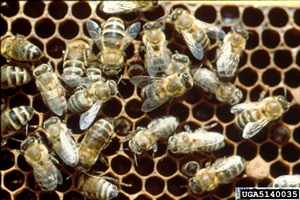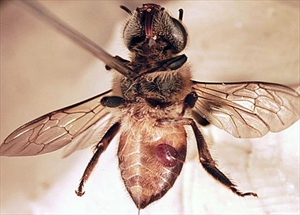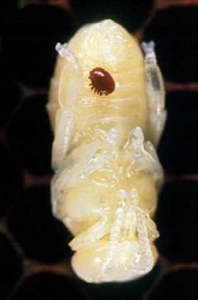Varroa mite, bee mite
Pacific Pests, Pathogens, Weeds & Pesticides - Online edition
Pacific Pests, Pathogens, Weeds & Pesticides
Varroa (jacobsoni) mite (326)
Varroa jacobsoni. Note, in 2000, research found that the population of Varroa jacobsoni was made up of two species, Varroa jacobsoni and Verroa destructor. The latter is the damaging species of European honeybees (see Fact Sheet no. 327).
Asia [including Indonesia (Irian Jaya)], the Philippines, and Malaysia], Africa, North, South and Central America, the Caribbean, Europe, Oceania. It is recorded from Australia (localised and under active eradication), New Zealand, Papua New Guinea, and Solomon Islands.
Asian honeybee (Apis cerana). The Asian honeybee has evolved with the mite, Varroa jacobsoni. The mite does not normally reproduce on the European honeybee (Apis mellifera) but, in 2008, a survey in Papua New Guinea found Varroa jacobsoni on male ('drone') and worker 'brood' (developing larvae and pupae).
This new strain of Varroa jacobsoni is widespread in Papua New Guinea, but it has not been found in Solomon Islands or Irian Jaya. In those two places, Varroa jacobsoni reproduces on Asian honeybees. However, in both places a very small number of mites were found that reproduce only on European honeybee male larvae.
The adult female mite is reddish-brown to dark brown, flattened, oval (like a crab), 1.0-1.8 mm long, 1.5-2 mm wide (Photo 1). Adult males are yellowish, with lightly tanned legs and spherical bodies, 0.75-0.98 mm long, 0.7-0.88 mm wide. On adult Asian honeybees, they are seen on the thorax or within abdominal folds (Photos 2&3).
One or two mated female mite enters a honeybee brood cell (where larvae and pupae develop) before it is closed, and each one lays 5-6 eggs; the nymphs hatch and feed on the bee larvae (Photo 4). The nymphs mature, mate, and the males die; the females attach themselves to the adult bees and feed on their blood (called 'haemolymph' in an insect).
Varroa jacobsoni only reproduces on male (drone) honeybee larvae as the bees can detect and remove them from worker bee larvae and worker brood cells. The mites are obligate parasites of honeybees and do not survive long away from the host.
Spread occurs easily within the hive as the mites are mobile. After hatching, they attach to an adult or infect other larvae and pupae. There are other ways, too: when bees rob the nectar from infected hives, when they enter by mistake, or when beekeepers place infested combs in non-infested hives. Long distance spread may also occur during normal habits of honey bees, i.e., swarming, robbing (taking nectar from other hives) and drifting (entering another hive by mistake).
The mites live for about 2-3 months. When the colony is not breeding and brood is absent, the mites survive fastened to adults, feeding on their haemolymph.
The Asian honeybee and the mite have evolved together, and because of this the bee has adapted to withstand varroa mite infestations. To reduce the impact of the mite, the workers remove them from the brood and brood cells. They do not normally reproduce on European honeybees, but exceptions have been found. The impact of these new strains is not yet known, but is likely to be considerable, leading to reduced honey production and pollination of food crops.
There are accepted ways of monitoring for mites, and three methods are provided. Early detection and reporting is important as it improves the chances of containing and eradicating introductions, therefore, monitoring should be done quarterly at least:
Method 1 (Uncapping drone cells)
- Uncap 100 drone brood cells and remove pupae, and examine each one for mites.
- Check for mites that have fallen from the pupae to the bottom of the drone brood cells.
- Do this on three frames in several hives selected at random.
Method 2 (Sugar shaking)
- Add 1 tablespoon icing sugar and approximately 300 bees (half a cup) and place in a jar with 1/8 inch gauze for a lid.
- Roll or gently shake the jar for 2-3 minutes.
- Leave for 2-3 minutes and shake again.
- Tip out the sugar through the mesh onto white paper, and look for mites.
- Return the bees to the hive.
- Repeat, sampling at least 5% of the hives on each occasion.
Method 3 (Sticky screens)
- Cover pieces of cardboard with a sticky substance (e.g., Vaseline).
- Cover cardboard with wire mesh (1/8 inch) that has holes too small for bees to pass through.
- Place the cardboard at the bottom of the hive or under a bee's nest.
- Count the number of mites that are caught in 24 hours.
The two species, Varroa jacobsoni and the more damaging Varroa destructor can be separated by DNA analysis.
QUARANTINE
Multiple genetically different populations of Varroa. jacobsoni exist. In Papua New Guinea, a strain has been found that has switched hosts and reproduces on European honeybees. There are other strains (in Solomon Islands and Irian Jaya) that partially reproduce at low levels on male European honeybees. Preventing the further spread of Varroa jacobsoni, and its strains, between countries is of the utmost importance. Countries may wish to enact legislation and devise codes of conduct to minimise the risk of introduction of exotic bee pests and diseases as well as managing those that are endemic. Such a code, developed in 2016 for Australia is provided as an example: http://beeaware.org.au/wp-content/uploads/2017/05/Australian-Honey-Bee-Industry-Biosecurity-Code-of-Practice.pdf, and the Biosecurity manual for beekeepers: http://www.planthealthaustralia.com.au/wp-content/uploads/2016/02/Biosecurity-Manual-for-Beekeepers.pdf.
CULTURAL CONTROL
There are a number of control measures aimed at commercial beekeepers as well as the general public. Some of these may form part of national biosecurity legislation to contain the entry of varroa mites and the spread of endemic pests. Notes, are also provided on physical and sanitation controls and those involving chemicals in case they are needed against strains of Varroa jacobsoni that infest European honeybees.
Surveys and sampling (for purposes of biosecurity):
- Place hives near ports and monitor them regularly for mites.
- Destroy any bees found at wharves and check to see if they are carrying varroa mites.
- Establish capability within biosecurity agencies to collect (and/or receive) samples from all beekeepers each year to check for presence of mites.
- Beekeepers should be encouraged to check their hives regularly, and report immediately any unexpected hive deaths, deformed bees, low larval numbers or larval deaths to biosecurity authorities.
Public awareness to control mites:
- Ensure that beekeepers are aware of the biosecurity threats that exist, both with the introduction of bees from other countries, and the mites (and other pests and pathogens) that they might bring.
Physical methods to control mites:
- Open-screen floors to hives. The mesh floor [1/8 inch (3 mm) holes] allows the mites to pass through as they are removed from adult bees when grooming, but not the bees themselves. This method alone can reduce mite populations by more than 10%.
- Do not use combs (hexagonal cells where queens lay eggs) from the brood area in the honey area.
Sanitation to control mites:
- Practise good sanitation and hygiene: ensure queen bees and equipment are from trusted sources and are pest free. Ensure that borrowed or second-hand equipment is cleaned and sterilised before use.
- Regularly clean and sterilise all tools, gloves, pallets, and boxes used.
- Replace brood combs (with foundation - made of wax to give bees a base for the honeycomb) every 3 years or before as there may be a build-up of mites. Used combs should be disposed of.
- Inspect brood combs regularly.
CHEMICAL CONTROL
There are times when it is necessary to sterilise hives and equipment. This might be when there has been a mite infestation, the hives and equipment are second-hand or before storage. EITHER:
- Place the hives in 1:5 diluted boiling sodium carbonate (washing soda) for 1-2 minutes, wash in clean water and dry. OR
- Place in 0.5% sodium hypochlorite for 20 minutes. (Note, household bleach is about 3%, so add one part bleach to five parts water).
Treatment of mites on the bees (see Fact Sheet no. 327):
- Tau-fluvalinate a (synthetic pyrethroid) has been used. The chemical is impregnated in strips which are hung on the brood frames. Here, they provide a slow release of the chemical. It is recommended that they remain in place for 6 weeks only, and also honey should be removed before the use of any chemical methods. Unfortunately, mite resistance to tau-fluvalinate has been documented, and there are effects on the bee population from this chemical, which in other circumstances is used as an insecticide. There is also a suggestion that the chemical increases the effects of Deformed wing virus, especially when first used.
- Thymol (derived from thyme). The product is released as a gel in the hive by placing it in a tray on top of the brood frames. It is a fumigant. Said to have no harmful effect on the colony, but may reduce egg-laying by queens.
- Other commercial products contain thymol with camphor, menthol and eucalyptus oil. A disadvantage is that they may taint the honey!
____________________
When using a pesticide, always wear protective clothing and follow the instructions on the product label, such as dosage, timing of application, and pre-harvest interval. Recommendations will vary with the crop and system of cultivation. Expert advice on the most appropriate pesticide to use should always be sought from local agricultural authorities.
AUTHOR Grahame Jackson
Information from BeeAware. Plant Health Australia. (http://beeaware.org.au/archive-pest/varroa-mites/#ad-image-0); and Biosecurity manual for beekeepers. (https://beeaware.org.au/wp-content/uploads/2019/05/Biosecurity-Manual-for-Beekeepers.pdf); Varroa mite (2020) Varroa mite detection in Townsville. Department of Agriculture and Fisheries. Queensland Government. (https://www.business.qld.gov.au/industries/farms-fishing-forestry/agriculture/land-management/health-pests-weeds-diseases/pests/invasive-animals/prohibited/varroa-mite). Photo 1 Lilia De Guzman, Bugwood.org. Photos 2-4 Walker K (2005) Varroa Mite (Varroa jacobsoni). PaDIL - (http://www.padil.gov.au).
Produced with support from the Australian Centre for International Agricultural Research under project PC/2010/090: Strengthening integrated crop management research in the Pacific Islands in support of sustainable intensification of high-value crop production, implemented by the University of Queensland and the Secretariat of the Pacific Community.







